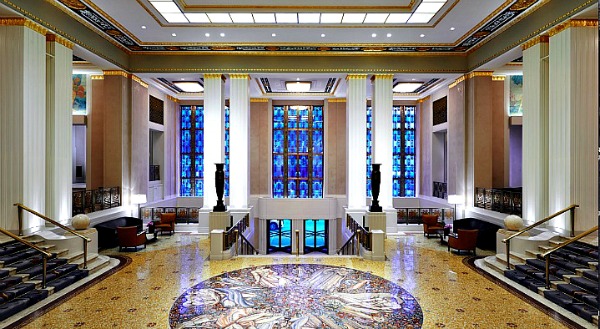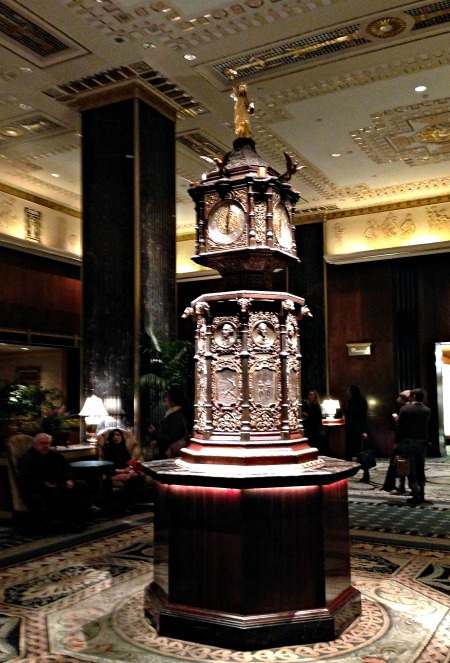Touring The Waldorf=Astoria, From the Kitchens to the Mirrors of Versaille
On a visit to the Waldorf=Astoria, I saw a notice for history tours of the hotel offered every Thursday and Saturday morning at 11:30.
Not many hotels boast sufficient history or chutzpah to warrant a tour priced at $50 a person (they do throw in lunch). Besides, the Waldorf devotes four bulging lobby display cases to memorabilia, from place settings for royal dinners to photos of illustrious guests, like Winston Churchill, John F. Kennedy and Bruce Springsteen. What more could there possibly be?

The Waldorf’s glorious Park Avenue lobby
I decided to find out. Besides, I’d always wondered why an equal sign connects the words Waldorf and Astoria.
On a recent Saturday morning, a friend and I joined the small group congregated around the main lobby’s Clock Tower, an enormous bronze crowned by a scaled down Statue of Liberty. Queen Victoria commissioned this elaborate concoction for the infamous Chicago World’s Fair of 1893 – remember The Devil in the White City? — a pertinent year because that’s when the original Waldorf Hotel was built. But we’re getting ahead of ourselves.
Our little group, comprised of hotel guests from Denmark, Australia, England and New Jersey, gathered around Joan, our guide, who led us to a portrait of William Waldorf Astor and recounted the hotel’s earliest days. With steel-gray hair secured with a bow and the brisk but cordial manner of a Chapin School history teacher, she was perfect — a Waldorf guide straight from central casting.
In brief: Today’s W=A descends from the old Waldorf Hotel, built by the aforementioned Astor on the corner of Fifth Avenue and 34th Street. A second hotel, the Astoria, was built by another branch of Astors in 1897 on an adjoining property, and a 300-foot marble promenade connected the two – hence the equal sign. So many swells strode it, it was called Peacock Alley.

The famous clock in the main lobby
In 1929, the Waldorf was razed to make way for the Empire State Building, and in 1931, today’s Waldorf=Astoria opened, bigger and flashier with state-of-the-art Art Deco trappings. Herbert Hoover delivered the welcoming address and became the first in an unbroken line of US presidents to check in.
It was the teeth of the Great Depression, but the Waldorf epitomized the era’s breadline-free-Fred-and- Ginger persona. Joan walked us through the Art Deco opulence of the soaring front lobby with its gigantic silver-leaf urns, Louis Rigal allegorical murals, gilded ceilings and Wheel of Life mosaic on the polished floor (150,000 tiny pieces – count ‘em).
Most of these trappings were carted off or boarded up in the 1950s when chandelier-lit Art Deco majesty was as outmoded as the Charleston and lowered ceilings, abstract paintings and floodlights ruled. Wall-to-wall carpeting shrouded the Wheel of Life for decades before damage to the carpet caused its removal – and the revelation of the glories beneath.

An original Waldorf elevator door
Stylistic sanity returned in the 1980s. With a team of conservators, artisans and carpenters,
the hotel poured millions into putting every thing back where it was originally. Well, just about everything. The lobby recently underwent a rehab that finished the process with a flourish — at last.
The tour took a welcome turn behind-the-scenes as Joan led us to an elevator in the Towers, the exclusive hotel within the main hotel. Suites here resemble classic Park Avenue apartments, spacious and comfortable but more timeless than stylish. No platform beds, no peek-a-boo showers, no television poles.
The enormous sitting room, dressed in reds and whites, featured floral sofas and striped fauteuils. The simple kitchen stressed functionality over beauty as if designed for a staff readying a UN delegation cocktail party rather than a guest chilling champagne for a tryst. That said, we’d have settled in contentedly.
Instead, we waltzed through the Starlight Room, so named because the original roof was retractable to allow dancing and drinks under the stars high above Park Avenue. (The roof became permanent when an enormous air-conditioning system was installed above it.)
The room looked like a flower mart, with masses of blooms – and an army of florists – wherever we glanced. Preparations for a lavish wedding that evening had gobbled up much of the hotel, as we discovered when we visited the cavernous four-story ballroom – more flowers, more florists – and the kitchens that encompass an entire floor.
Heavenly scents wafted our way as we entered the baking area, where a white-coated staff
member passed around a tray of freshly baked tea cookies. I could have lingered over orange marmalade thumbprints and buttery elephant ears for hours.

The Cole Porter piano
Joan, however, had other plans. Good ones. A look at a private meeting space whose mile-high ceilings and wall panels were harvested from an 18th-century English manse. A walk through the hotel’s famed Hall of Mirrors fashioned after the original at Versailles. A final visit to the Lobby Clock (the Statue of Liberty, added after the World’s Fair, was not Victoria’s idea).
It was time for lunch. Like the tour, it unfolded gracefully. Oscar’s Brasserie, named for Oscar Tschirky, the famed Waldorf maitre’d said to have had a hand in the creation of Eggs Benedict and Waldorf Salad, serves a bang-up buffet brunch –warm dishes like egg casserole, corn-beef hash, waffles and bespoke omelets, salads (including Waldorf), breads and bagels galore and a fleet of desserts. My favorite: the pancakes sprinkled with powdered sugar.
My take on the tour? Forget it if you’re not a history buff. But for two and a half hours I was transported to another world. And that’s the closest to time travel a hotel can offer.
Reservations required: to book, call 212 872-1275.

Leave a Reply
Want to join the discussion?Feel free to contribute!